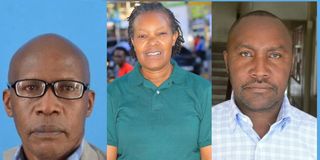Back then in the newsroom: Nakuru's pioneer journalists speak

(From left) Francis Mureithi, Wanjiru Macharia and Raphael Munge who are pioneer journalists in Nakuru.
‘They broke ground so we could plant roots’ is perhaps the best way to describe the pioneering journalists shaping Nakuru’s media landscape today.
Among them is Francis Mureithi of Nation Media Group, who could easily be regarded as one of the founding figures of science journalism, having started out without bylines.
With over 20 years of experience, Mureithi is known for his meticulous attention to detail and ability to translate complex scientific concepts into accessible, engaging stories.
Mureithi has covered two consecutive UN Climate Change Conferences (COPs), reporting on issues of global relevance while connecting them to the local context.
“Science is a lens through which we understand everyday life, from the water we drink to the food we eat and how these are shaped by environmental and health challenges like aflatoxins or shifting weather patterns,” he says adding that his coverage has been made possible by the ability to specialize as one of the changes in the industry after starting as a sports reporter.
His stories have not only informed the public but also reached policymakers, prompting them to reassess regulations, identify gaps, and take corrective action.
Other changes the founder of Media for Environment, Science, Health and Agriculture in Kenya (MESHA) says is there has also been a shift with scientists and researchers being more friendly and offering information more, something they had to earn.
“Journalists need to know they have power. You’re just a lead, someone else will take it to the next level,” he says adding that if a journalist does not think of making an impact they’ll remain part of a routine conveyor belt.
Mureithi’s work has been published in other outlets like the BBC, and MESHA.
Another long-time journalist is Wanjiru Macharia who notes that when she started, journalists were paid per centimeter per column.
Despite the additional perks in modern-day journalism, she says journalists’ remuneration is still lacking.
Starting as a court reporter and climbing up the corporate ladder to Acting Bureau Chief, she is now among the few female science (agriculture) journalists in the region. She notes that journalism has become more humanized.
“Journalism today is approached with more care. There is improved psychological support available for journalists, and they are encouraged to mentally prepare themselves before covering gruesome or traumatic scenes. That didn’t exist back then,” she says.
Like Mureithi, she agrees that specialization has opened doors for journalists to pursue their specific interests.
“With specialization, journalists can apply for specific grants, access targeted training, and even gain travel opportunities because they are more knowledgeable in their fields,” she says.
With over two decades of experience, some of her most memorable stories include one about a woman with a severe breast condition that moved readers to offer help, and another covering the high-profile land dispute case between President Moi and Malcolm Bell, reporting on it until Bell finally regained his land.
Wanjiru has worked for Nation Media Group, The Star, People Daily, The Standard, Capital FM, and The Guardian, among many others.
Raphael Munge, a photojournalist with Mediamax, has over three decades of experience, during which his images have brought life and immediacy to unfolding stories.
Having worked for Nation Media Group, The Standard, and People Daily, he believes that what matters most in journalism is integrity, focus, truthfulness, and faithfulness.
“Journalists need to understand that they are the people’s eyes and are depended on for truthful information and accountability,” he says. “If you focus too much on money, you won’t go far. Worse still, you may be tempted to compromise your ethics. Some journalists have lost their way, turning to extortion and unethical practices.”
What brings him the greatest satisfaction, he says, is when one of his stories or photos helps someone in need. “When I do something that has an impact, it gives me fulfillment,” he adds.
Munge reflects on how much journalism has evolved since he started.
“We used to use analog cameras with film. We’d take photos, process and print them, then send them to Nairobi as a package. Now everything happens instantly. Even photo quality could only be determined after printing, unlike today where it’s immediate,” he says.
He also mentors upcoming photojournalists, showing them the kind of integrity, respect, obedience, and honesty required to thrive in the trade.
“There are no shortcuts. If you come in with tricks or dishonesty, it won’t take you far. That’s why journalists need to be principled and uphold integrity in everything they do,” he says.
According to Munge, the future of journalism is bright but will be very challenging with the advent of social media and AI. “Journalists need to upskill to keep pace with the evolving industry,” he adds.
Other veteran journalists considered to have built the media industry in Nakuru include Beatrice Obwocha, Director of Communications at the Ministry of Trade and Industry; Mary Miano, Michael Njuguna, Martin Masai, Patrick Wachira, John Kiama, Odhiambo Olale, and Ngumo wa Kuria, among others.
Here’s to press freedom, the bad, but mostly the GOOD.


